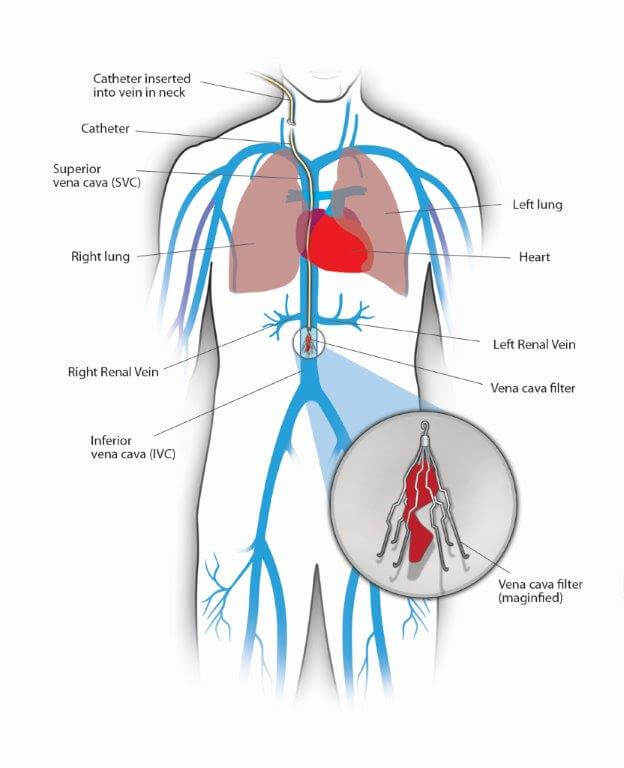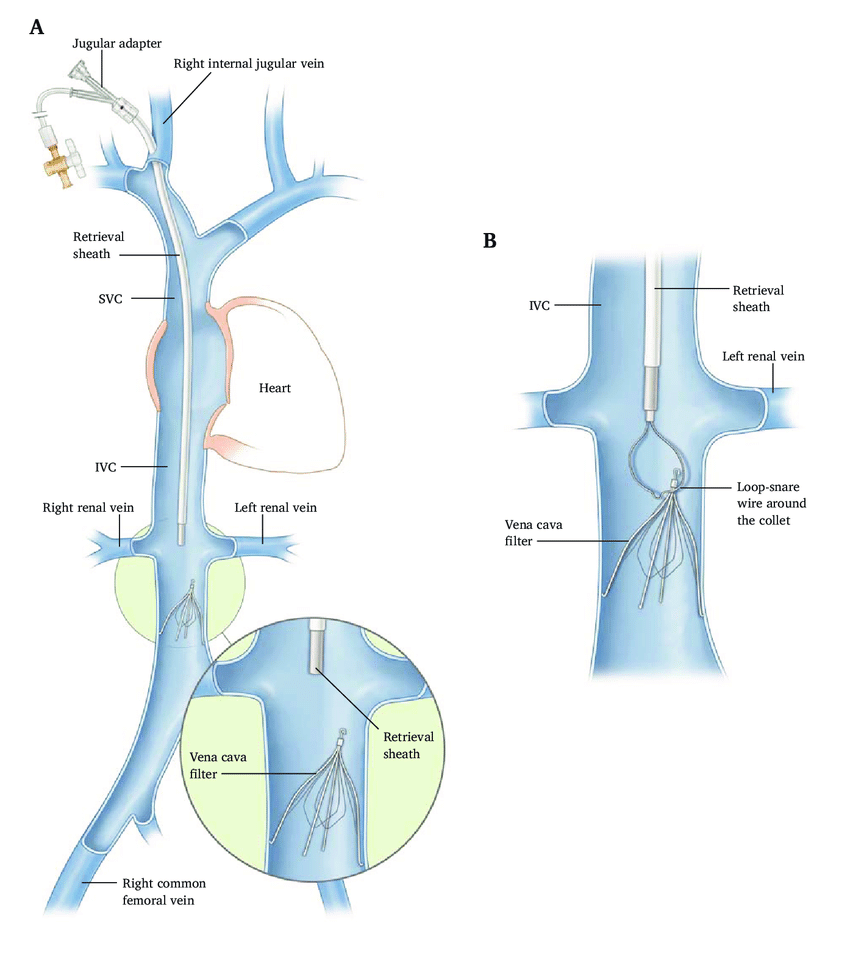IVC FILTER DEPLOYMENT/RETRIEVAL

An inferior vena cava (IVC) filter is a small, cage-like device placed in the inferior vena cava, the large vein that returns blood from the lower body to the heart. The filter’s purpose is to trap blood clots (pulmonary emboli or PE) that could travel to the lungs and cause serious blockages.
IVC Filter Deployment:
- Procedure: This is usually a minimally invasive procedure performed by an interventional radiologist (IR doctor) using fluoroscopy (real-time x-rays). The doctor accesses a vein in the groin or neck and guides a catheter with the collapsed filter to the IVC. Once positioned, the filter is deployed, expanding to capture any clots.
- Indications: IVC filters are used in patients with a high risk of PE but who cannot tolerate blood thinners (anticoagulants). This risk can arise from recent surgery, trauma, or certain medical conditions.
IVC Filter Retrieval:
- Procedure: Similar to deployment, a catheter is used to access the filter. Retrieval techniques vary depending on the filter type, but generally involve collapsing the filter and extracting it through the catheter.
- Indications: Ideally, IVC filters are temporary. Retrieval is recommended once the risk of PE subsides and blood thinners can be resumed. However, some filters are retrievable only for a specific timeframe. There are also situations where retrieval may be difficult or contraindicated, and the filter may be left in place permanently.
IR Treatment:
Interventional radiology (IR) plays a crucial role in both deployment and retrieval of IVC filters. IR doctors are specially trained in using image-guided minimally invasive procedures. Here’s how IR is involved:
- Guidance: Fluoroscopy provides real-time x-ray images that help the doctor navigate the catheter and position the filter precisely.
- Catheterization: IR doctors are adept at navigating catheters through the vascular system to reach the IVC.
- Alternatives: In some cases, IR techniques may offer alternative approaches for clot management. For example, clot retrieval devices can be used to remove existing clots from the veins.
Additional Points:
- There are different types of IVC filters with varying retrieval characteristics. The choice of filter depends on individual patient needs.
- IVC filters are not without risks. Potential complications include filter migration, penetration of the caval wall, and thrombosis (clot formation) in the filter itself.
- Discussing the benefits and risks of IVC filter placement and retrieval with your doctor is crucial for making informed decisions about your care.

Types of IVC Filters:
- Retrievable vs. Permanent: Retrievable filters are preferred as they can be removed once the risk of PE subsides. Permanent filters are left in place long-term, but retrieval may be attempted if complications arise.
- Recovery Hooks and Retrieval Sheaths: These are specialized tools used by IR doctors to capture and extract the filter during retrieval procedures. The type used depends on the specific filter design.
- CavaGuard: This unique filter is placed in the inferior vena cava cava access (the small vein that joins the IVC just before it enters the heart). It’s designed for long-term placement and may be retrievable in some cases.
IR Techniques for Clot Management:
- Catheter-Directed Thrombolysis: Clot-busting medication is delivered directly to the clot through a catheter to dissolve it.
- Mechanical Thrombectomy: A specialized catheter with a retrieval basket or other mechanism is used to remove the clot physically.
Complications:
- Filter Migration: The filter can detach and move to a different location within the vein, potentially causing blockage or damage.
- Penetration of Caval Wall: The filter can pierce the wall of the vena cava, requiring complex procedures for removal.
- Filter Thrombosis: Clot formation on the filter itself, defeating its purpose and potentially causing complications.
- Caval Stenosis: Scarring around the filter can narrow the vena cava, impeding blood flow.
Choosing the Right Approach:
The decision to deploy or retrieve an IVC filter involves a careful evaluation of individual patient factors by a team including the vascular surgeon, hematologist (blood specialist), and interventional radiologist. They will consider:
- Risk of PE: How high is the patient’s risk of developing blood clots that could travel to the lungs?
- Blood Thinners: Can the patient safely take blood thinners to manage the clot risk?
- Underlying Medical Conditions: Are there any medical conditions that make placement or retrieval of the filter high-risk?
- Type of Filter: Selecting the most suitable filter based on retrievability, patient anatomy, and anticipated duration of use.
Looking Forward:
Research is ongoing to develop even more advanced IVC filters and retrieval techniques. Here are some promising areas:
- Biodegradable Filters: These filters would dissolve naturally over time, eliminating the need for a separate retrieval procedure.
- Improved Retrieval Techniques: Newer tools and methods to make filter retrieval safer and more efficient, especially for long-term filters.
- Better Risk Stratification: Developing more accurate methods to predict which patients would benefit most from IVC filters.
By understanding the nuances of IVC filter deployment/retrieval and IR treatment, patients and healthcare professionals can work together to make informed decisions about this important intervention.











